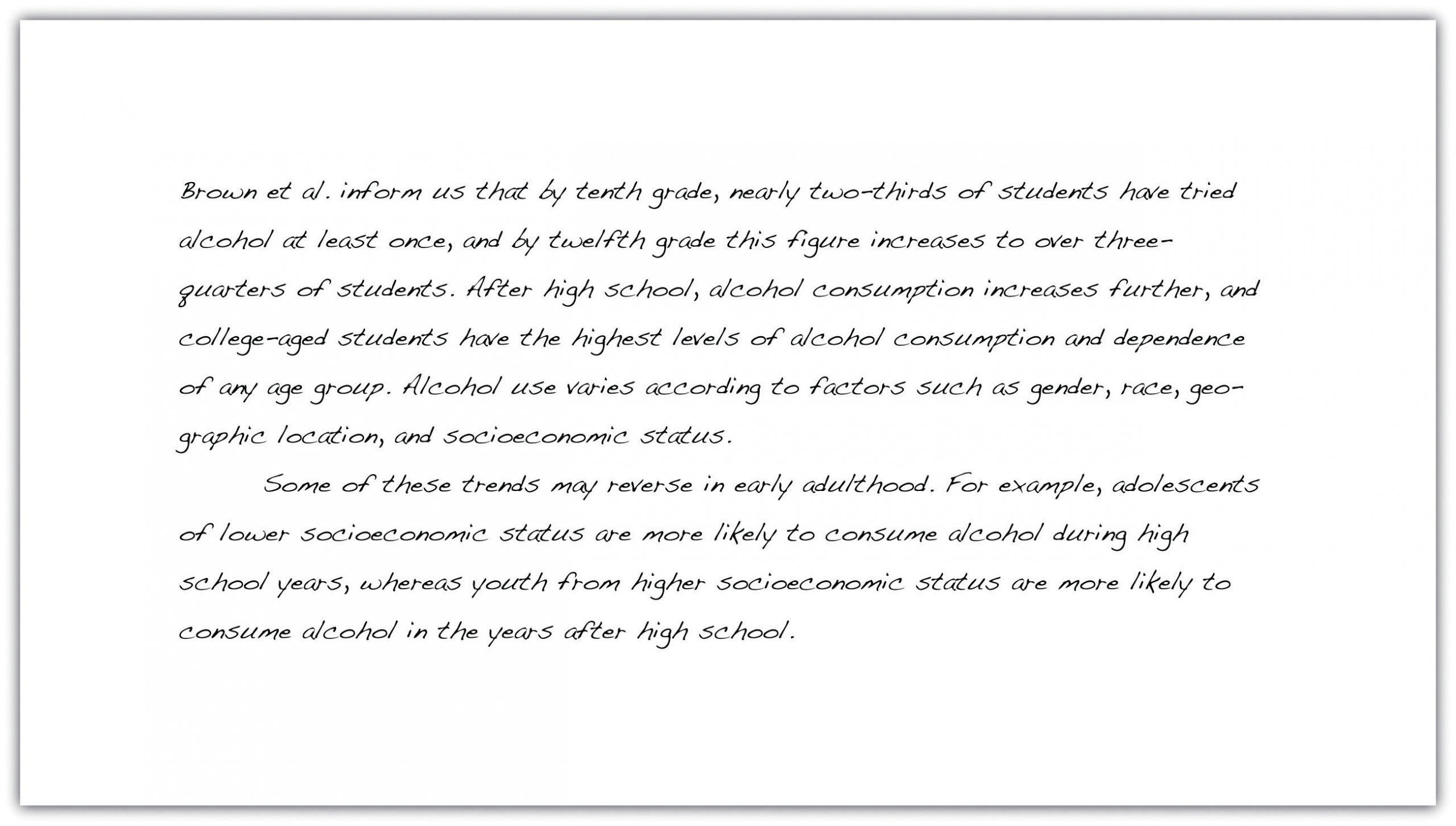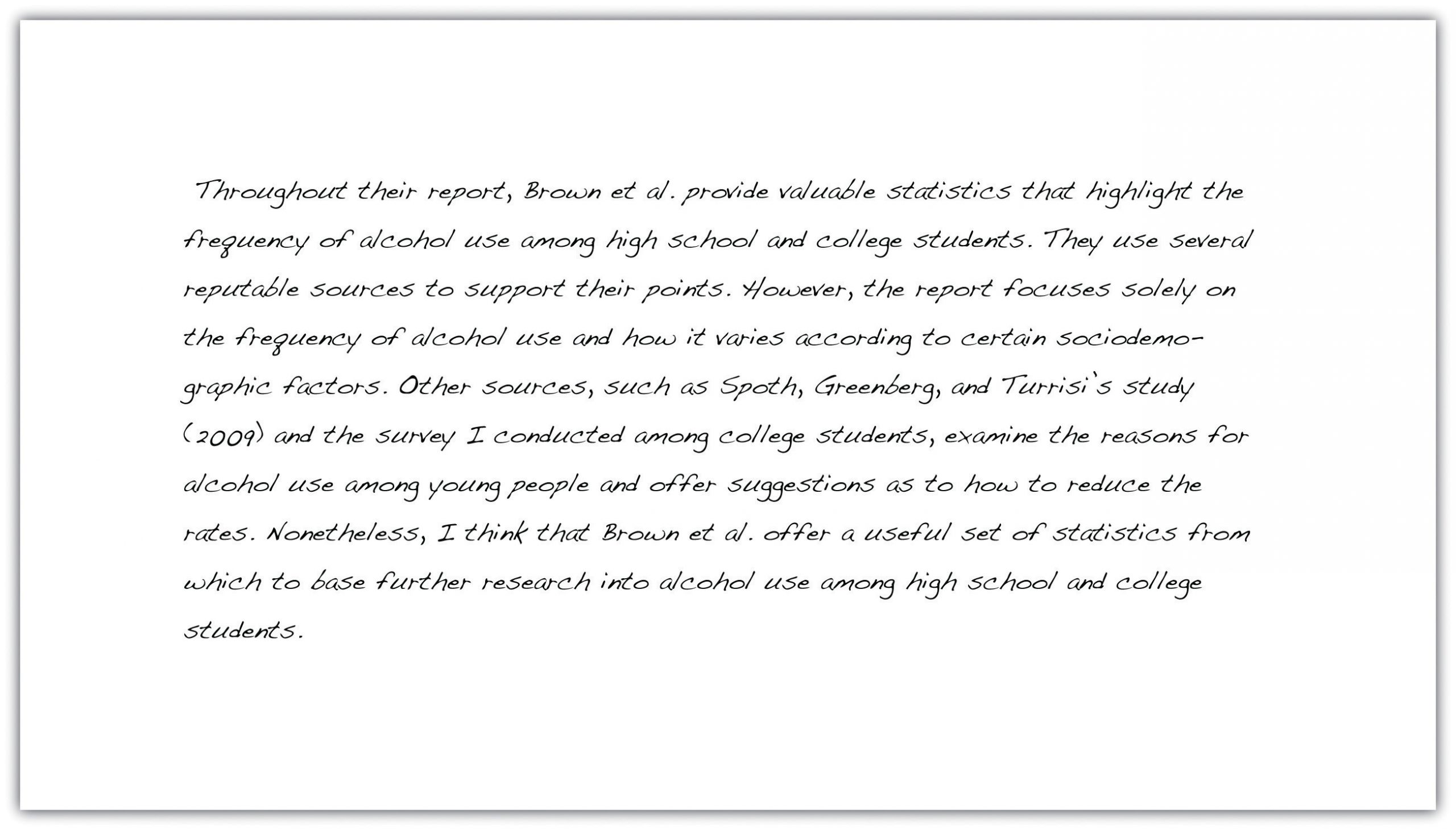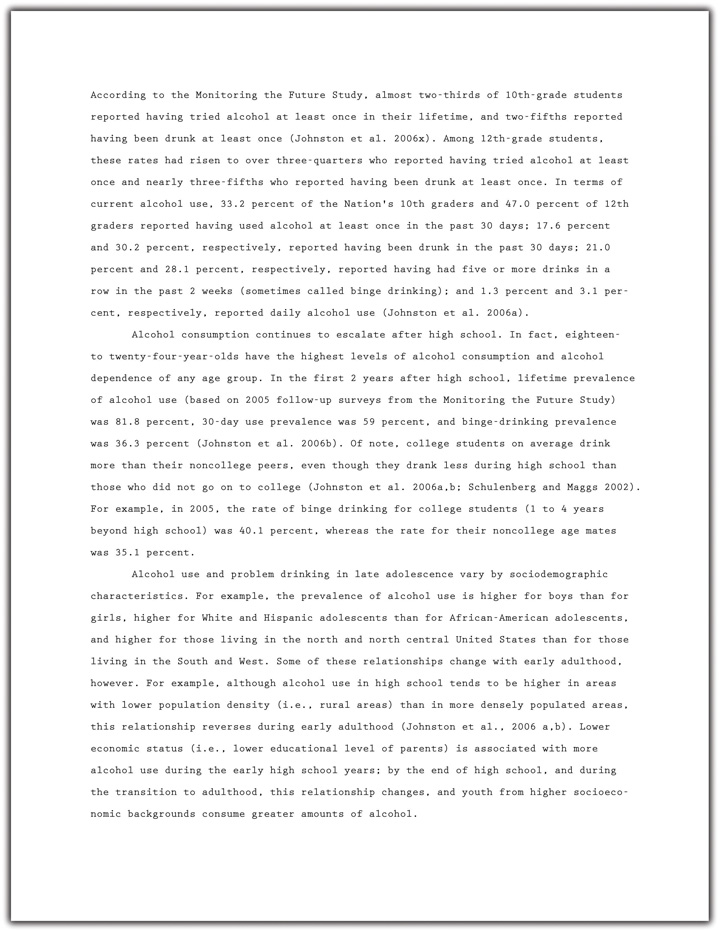5.2 Stand-alone Paragraphs
Preview
This section of Ch. 5 will cover the following topics:
- summaries and evaluations
- critical thinking
- audience and tone
Often in college, you will be asked to write short responses, whether to a reading assignment or on an essay test. An instructor may ask you to respond to a short story, explain the main points in a chapter in a history textbook, or report back on a lab experiment. Often these responses will be single paragraphs. Two common types of stand-alone paragraphs are summaries and evaluations.
Summary Paragraphs
A summary is a significantly shortened version of another, longer piece. A summary gives only a general sense of the information, capturing the main ideas, without necessarily following the order or emphasis of the original. A summary is always written in your own words. “Borrowing” words and phrases from the original can be seen as plagiarism. Be careful!
You probably summarize every day. At some point in a casual conversation with a friend or coworker, you compressed a two-hour movie into a brief description. You described the major highlights in a few sentences, using your own words. That is a summary.
A summary will do the following:
- maintain the meaning of the original document
- contain all the main points, without the supporting details
- not include your opinion
In writing a summary, you have to judge what is important and what isn’t. The easiest way to do this is to “mark up” the document you want to summarize as you read it–identifying the topic, the main supporting details, and any other significant points. Those notes are easily turned into a summary.
Read this report on a study of alcohol use among young adults:
Now read the following summary written by a student:
 Notice how the summary retains the key points of the original report but omits most of the statistical data. Also, notice this writer has used his own words to explain the information. Words like “respectively,” “continues to escalate,” and “lifetime prevalence” belong to the expert who wrote the original report.
Notice how the summary retains the key points of the original report but omits most of the statistical data. Also, notice this writer has used his own words to explain the information. Words like “respectively,” “continues to escalate,” and “lifetime prevalence” belong to the expert who wrote the original report.
How to Write a Summary
- Carefully read the original document, making notes as you go. (This might be a good time to re-read the Adler essay in Ch. 7.1.) You must fully understand something before you try to explain it to someone else.
- Then, put the original away. This is crucial; if you glance at the original now and then, you will accidentally copy words or sentence structures. Summarizing without referring to the original also forces you to understand the material before trying to explain it.
- Write a single sentence that explains the original. This is your topic sentence.
- Identify the main points in the original. (You may refer to your notes, but do not look at the original.) Briefly explain each point. These are your supporting details. Organize your points in a logical way.
- Check that you have not included your opinion; a summary explains but does not comment on the original.
- Add a concluding comment that refers to but does not repeat the topic sentence.
- Re-read the original to be sure you didn’t miss anything important.
A summary will be far shorter than the original. It should include just enough information to recount the main points.
- a summary of a paragraph should be one or two sentences
- a summary of a chapter or an essay might be a paragraph or maybe two
- a summary of a whole book might be one or two pages
It takes practice to be able to pull the essential information from a piece of writing, but there are many benefits to doing so. And you will be asked to do this task again and again in college.
Exercise 1
Go to Ch. 7 and read one of the following essays:
- “Accomplishing Big Things in Small Places” by William Wissemann
- “Fun. Oh boy. Fun. You Could Die from It” by Suzanne Britt Jordan
If possible, print the essay so you can mark it up. If you can’t do that, take good notes as you read.
Then, write a summary of the essay in your notebook. Follow the steps outlined above.
Your summary should be a single paragraph (at least 100 words but no more than 200). Be sure your paragraph has a topic sentence, clear supporting points, and a concluding comment.
Evaluation Paragraphs
An evaluation judges the value of something and determines its worth. Evaluations are based on set standards but influenced by opinion and prior knowledge.
At work, a supervisor may evaluate an employee based on how well he meets the company’s goals, but the evaluation also includes the supervisor’s opinion and prior experience of the employee.
In college, when a student expresses an opinion about a document or a topic, that evaluation should be based on specific criteria, careful reading, and any prior knowledge of the topic.
Read a student’s evaluation of the report above:
 Notice how the paragraph incorporates the student’s personal judgment. Because an evaluation incorporates your point of view and reasons, it requires more critical thinking than a summary.
Notice how the paragraph incorporates the student’s personal judgment. Because an evaluation incorporates your point of view and reasons, it requires more critical thinking than a summary.
Critical Thinking
We know what “thinking” is. To “be critical” often means to be disapproving. But in college, “critical thinking” means actively analyzing something (a poem, a piece of music, a political issue) using observation, reflection, and reason to draw a conclusion.
To engage in critical thinking, a student must be willing to do three things:
- gather evidence: read carefully with the goal of fully understanding the material
- apply criteria: use specific standards to evaluate the material
- demonstrate judgment: think reasonably using previous experience and knowledge
How to Write an Evaluation
- Carefully read the original document, taking notes as you go. You must fully understand it before you have a right to an opinion.
- Take ten minutes to jot down your thoughts. Start simply: Did you like it? Why or why not? Then get more specific. What did the writer do that was effective? Were there any problems? What observations did you make as you read?
- Identify several criteria for evaluation. For example, you might consider the way the piece was organized, or how well the writer supports her point, or whether the information was repetitive or the language evocative.
- In one sentence, write your opinion. Name the document and the writer in this sentence so we know what you are evaluating. This is your topic sentence.
- Then, provide examples from the original to support your opinion.
- Organize your supporting points logically and use transitions to connect your points.
- Wrap up with a final thought that reflects your opinion but doesn’t repeat things you’ve already said. That is your concluding sentence.
- Re-read the original essay to be sure you didn’t miss anything important.
Exercise 2
Re-read the essay you chose for Exercise 1, making additional notes.
Following the steps above, write an evaluation paragraph on the essay in your notebook.
Be sure your opinion is the focus of your paragraph, that you use supporting details to explain your opinion, and that your concluding comment refers to your opinion. An evaluation paragraph is your judgment of the original, but it is not just your gut feeling. A judgment should be based on reason.
Your evaluation should be a single paragraph (at least 100 words but no more than 200 words).
Audience and Tone
Being aware of readers is a skill you likely already possess. Consider the following paragraphs. Which would the author send to her parents? Which would she send to her best friend?
Last Saturday, I volunteered at a local hospital. The visit was fun and rewarding. I even learned how to do cardiopulmonary resuscitation, or CPR. Unfortunately, I think I caught a cold from one of the patients. I hope I am well by next Saturday to volunteer again.
OMG! You won’t believe this! My advisor forced me to do my community service hours at this hospital all weekend! We learned CPR but we did it on dummies, not even real peeps. And some kid sneezed on me and got me sick! I hope I don’t have to go back next week. I def do NOT want to miss the basketball game!
Most likely, you matched each paragraph to its intended audience easily.
Just as speakers transmit emotion through voice, writers transmit a range of attitudes with sentence structure, punctuation, and word choice. In the second example above, notice the writer uses slang (“OMG,” “peeps,” “def”), casual punctuation (!), and informal sentence structure (starting a sentence with “And”).
A writer’s tone should always match the audience and the purpose of the piece of writing. When you write college assignments, remember who the reader is: your instructor and possibly your classmates. The tone of college writing is slightly formal–not casual, but not stiff. Sound like yourself, but the way you would speak in a formal situation.
Takeaways
- Common types of paragraphs in college include summaries and evaluations.
- Summaries do not include your opinion; evaluations do.
- Critical thinking means actively analyzing something using observation, reflection, and reason to draw a conclusion.
- Writing must be appropriate in tone for the purpose of the document and the intended audience.
the standard or model used for comparison


